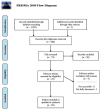Recent Advancement of Clinical Information Systems: Opportunities and Challenges
- PMID: 30157510
- PMCID: PMC6115226
- DOI: 10.1055/s-0038-1667075
Recent Advancement of Clinical Information Systems: Opportunities and Challenges
Abstract
Objectives: Clinical information systems (CISs) have generated opportunities for meaningful improvements both in patient care and workflow but there is still a long way to perfection. Healthcare providers are still facing challenges of data exchange, management, and integration due to lack of functionality among these systems. Our objective here is to systematically review, synthesize, and summarize the literature that describes the current stage of clinical information systems, so as to assess the current state of knowledge, and identify benefits and challenges.
Methods: PubMed, EMBASE, and the bibliographies of articles were searched for studies published until September 1, 2017, which reported on significant advancement of clinical information systems, as well as problems and opportunities in this field. Studies providing the most detailed information were included and the others were kept only as references.
Results: We selected 23 papers out of 1,026 unique abstracts for full-text review using our selection criteria, and 20 out of these 23 studies met all of our inclusion criteria. We focused on three major areas: 1) Ambulatory and inpatients clinical information systems; 2) Specialty information systems; and 3) Ancillary information systems. As CIS can support evidence-based practices that, in turn, improve patient's safety, quality and efficacy of care, advancement, acceptability, and adaptability of CIS have increased worldwide. Although, the demand for CIS functionality is rising fast, current CISs still have data integration challenges and lack of functionality to exchange patient information from all or some parts of the healthcare system. These limitations can be attributed to technical, human, and organizational factors Conclusion: Clinical information systems provide tremendous opportunities to reduce clinical errors such as medication errors and diagnostic errors and to support healthcare professionals by offering up-to-date patient information. They promise to improve workflow and efficiency of care, thus boosting the overall quality of healthcare.
Georg Thieme Verlag KG Stuttgart.
Conflict of interest statement
Disclosure The authors report no conflicts of interest in this work.
Figures
References
-
- Andel C, Davidow S L, Hollander M, Moreno D A. The economics of health care quality and medical errors. Journal Health Care Finance. 2012;39(01):39–50. - PubMed
-
- Makary M A, Daniel M. Medical error-the third leading cause of death in the US. BMJ. 2016;353:i2139. - PubMed
-
- Mackel J, Farris H, Mittman B, Wilkes M, Kanouse D.A Windows-based tool for the study of clinical decision-making MEDINFO 19958Pt2:1687. - PubMed
Publication types
MeSH terms
LinkOut - more resources
Full Text Sources
Other Literature Sources
Research Materials
Miscellaneous



